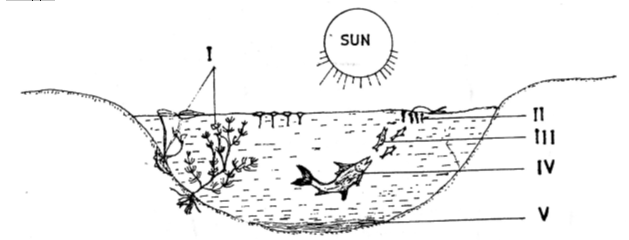Question 3
- The diagram below is an illustration of organisms in a habitat. Study it and answer questions 3(a) to 3(c).

(a) (i) Name the habitat.
[1 mark]
(ii) Name the trophic level occupied by each of the organisms I, II, III and IV in the habitat.
I:
II:
III:
IV:
[4 marks]
(iii) Construct a food chain using the organisms labelled in the diagram.
[5 marks]
(b) (i) What is the role of the sun in the habitat?
[3 marks]
(ii) If the organisms labeled I are present, what would be the effect on the habitat?
[4 marks]
(c) Name two:
(i) biotic components in the habitat;
(ii) abiotic components in the habitat.
[4 marks]
(d) Name the mode of nutrition of each of organisms I, II, III and IV. [4 marks]
(e) State two adaptive features of the organisms labelled I to their mode of life in the habitat.
[4 marks]
(f) Name the part labelled V. [1 mark]
Observation
Candidates performed fairly in this question. Many of the candidates were able to identify the habitat correctly as a pond and state the trophic level of the labelled organisms.
Many of the candidates were also able to construct a food chain involving the organisms.
The expected answers are:
(a) (i) Name of habitat
(Fresh water) pond.
Note: spellings must be correct to score.
(ii) Trophic level of labelled parts
I - producer/first/1
II - primary consumer/second/quaternary/2
III - secondary consumer/tertiary/3
IV - tertiary consumer/quaternary/4
(iii) Food chain
I/plants II/tadpole III/small fish IV/big fish Note: Any two correct arrows to score one mark.
Position of four organisms to score one mark each.
(b) (i) Role of the sun in the habitat
- the sun is a source of solar/light energy;
- for plants to use to manufacture food/photosynthesis;
- promotes the growth of plants;
- keeps the water warm/increase in temperature.
(ii) Effect of the absence of the organisms labelled I in the habitat
- if they are absent, the solar/light energy is not fully utilized/captured;
- food is not manufactured/ produced for the animal;
- oxygen is not released into the water;
- therefore life cannot be sustained;
- animals find it difficult to breathe;
- carbon dioxide accumulates;
- and the environment becomes polluted;
- eventually all the organisms die.
(c) (i) Biotic components in the habitat
- Plants/water plants;
- Animals/fish/tadpole/mosquito larva(e).
(ii) Abiotic components in the habitat
- Water
- Soil/humus
- Temperature
(d) Mode of nutrition of labelled parts
I - autotrophic/holophytic/photosynthetic
II - herbivorous/holozoic/heterotrophic
III - carnivorous/holozoic/heterotrophic
IV - carnivorous/holozoic/heterotrophic
(e) Adaptive features of the organism labelled I to their mode of life in the habitat
- Well-developed numerous fibrous root system; for anchorage into mud;
- Long petiole; raises the leaves above water; for photosynthesis;
- Numerous root hairs; for absorption of nutrients;
- Air spaces/spongy tissues; for buoyancy/floating;
- Broad leaves; enhances absorption of sunlight for photosynthesis;
- Presence of chlorophyll/chloroplast for photosynthesis.
(f) Name of the part labelled V
Soil/Mud/debris/humus/organic matter/decomposed matter/detritus.
